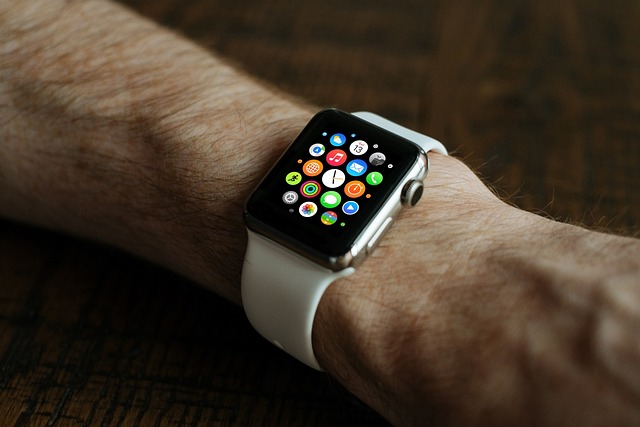To maintain an optimal battery life for your Apple Watch, it's crucial to personalize settings based on your usage habits and regularly update its software. Key strategies include managing app complications, disabling features like always-on display and raised-wrist detection during inactive periods, and utilizing energy-saving modes. Notifications should be filtered to prevent frequent interruptions, especially at night or during focused tasks. Workout tracking can drain the battery quickly; therefore, use Power Saving Mode during exercise, stop the workout session manually, and employ features like Auto-Pause. If your watch shows signs of reduced responsiveness or shorter battery life, it may be time to replace the apple watch battery. Apple recommends a replacement when the battery's capacity falls below 80% to ensure peak performance and extend its lifespan. Regularly monitoring your device's performance will help you decide when such maintenance is necessary, thereby avoiding frequent replacements and ensuring your Apple Watch remains efficient and reliable.
5 Tips to Prolong Your Apple Watch’s Battery Life and When to Replace Its Battery
Maximizing your Apple Watch’s battery life is a blend of understanding its energy patterns, customizing settings, and optimizing usage. This guide offers actionable tips tailored for the discerning user looking to enhance their watch’s endurance. From disabling non-essential features to managing notifications wisely, learn how these strategies can make a difference in your daily experience with the device. Additionally, we’ll navigate when it’s time to replace your Apple Watch battery for peak performance, ensuring your smartwatch serves you efficiently for years to come.
- Understanding Your Apple Watch's Power Consumption Patterns
- Tips for Extending Apple Watch Battery Life Between Charges
- Customizing Watch Faces to Save Battery on Your Apple Watch
- Optimizing Apple Watch App Usage to Minimize Energy Drain
- Essential Features to Disable for Longer Apple Watch Battery Life
- Monitoring and Managing Notifications on Your Apple Watch
- Strategies for Efficient Use of Workout Tracking on Apple Watch
- When to Consider Replacing Your Apple Watch Battery for Maximum Performance
Understanding Your Apple Watch's Power Consumption Patterns

To optimize your Apple Watch’s battery life, it’s crucial to recognize the patterns that contribute to its energy consumption. The Apple Watch, like many other electronic devices, has specific features and activities that can drain its battery more quickly than others. For instance, the always-on display, while convenient for at-a-glance information, is a notable power user compared to a watch face that wakes upon raise to wrist or a tap. Understanding which complications you use most frequently can also inform your decisions about which features to keep active and which to disable to extend battery life. Background processes such as heart rate monitoring, workout tracking, and fitness challenges are designed to run efficiently, but they do require more power than some of the watch’s less dynamic functions.
To manage these consumption patterns effectively, consider customizing your Apple Watch settings to match your daily routine. For example, if you only need to track your workouts during specific times of the day, you can disable workout tracking when it’s not in use. Similarly, reducing the frequency of complications that update regularly, such as the weather or activity progress, can make a significant difference over the course of a day. Additionally, opting for an ‘Optimized Battery Charging’ setting, which learns your charging habits and tops up the battery just before you’re likely to wake up, can prevent unnecessary overnight power use. By consciously engaging with these settings and understanding how different features affect your watch’s battery life, you can make informed decisions that will help you replace the Apple Watch battery less frequently. This proactive approach not only saves you from unexpected battery depletion but also ensures that your device is always ready when you need it most.
Tips for Extending Apple Watch Battery Life Between Charges

To extend your Apple Watch’s battery life effectively between charges, consider implementing several strategies that balance performance with power conservation. Firstly, customize your watch face to display time and necessary complications only, as more information means greater energy consumption. Dimming the screen after a short while of inactivity or reducing the brightness setting can significantly prolong battery duration. Additionally, enable ‘Power Saving Mode’ when your watch’s charge is low; this feature minimizes background processing and hibernates unnecessary features to eke out the remaining power.
For more long-term solutions, you might think about replacing your Apple Watch battery if it’s showing signs of degradation. This is particularly advisable if your device is more than a few years old or has undergone multiple software updates, as these can take a toll on the battery’s capacity over time. Opting for an official Apple service to replace the battery ensures that your watch’s components are handled with care and maintain their functionality. Furthermore, regularly updating your watch’s software not only keeps it secure but also optimizes its performance, indirectly contributing to battery efficiency. Regular maintenance and understanding how you use your Apple Watch can help you make informed decisions about when a battery replacement might be necessary, ensuring that your device remains a reliable companion throughout your day.
Customizing Watch Faces to Save Battery on Your Apple Watch

To extend the battery life of your Apple Watch, particularly if it’s an older model or you’re facing a drained battery more frequently than usual, customizing your watch face can be a straightforward and effective solution. The Apple Watch’s interface is both intuitive and feature-rich, allowing users to tweak their watch faces for optimal performance. Opting for simpler, less interactive watch faces like ‘Simple’ or ‘Utilitarian’ can significantly reduce energy consumption. These minimalistic designs require fewer resources to display, as they don’t include dynamic elements like animations or complications that continuously update information.
Furthermore, when selecting a watch face with complications, consider which ones are truly necessary for your daily use. Each complication is a small application running in the background, so removing those you seldom check can make a noticeable difference. For instance, if you don’t need to see the weather or the moon phase at a glance, disable these to streamline your watch face and minimize battery drain. Additionally, utilising the ‘Energy-Saving Mode’ within the Apple Watch settings when your battery is low can also help conserve power until you have an opportunity to replace the apple watch battery or charge it fully. By thoughtfully customizing your watch face and being mindful of the complications you keep active, you can enjoy longer battery life between charges, ensuring your Apple Watch is ready whenever you need it.
Optimizing Apple Watch App Usage to Minimize Energy Drain

To extend the battery life of your Apple Watch, it’s crucial to manage app usage effectively. The Apple Watch, like many smart devices, relies on energy to power both its hardware and its applications. By optimizing which apps you use and how frequently, you can significantly reduce the drain on your watch’s battery. Start by reviewing the apps installed on your device and prioritize those that are most essential to your daily routine. Remove or limit the use of apps that are not necessary, as these can run in the background, consuming energy even when not actively in use. Additionally, customize app complications to ensure they display the information you need without unnecessary interactions.
For users frequently on the go, configuring the Glance feature is another key step. Only add Glances for apps that provide essential information or that you check often. This prevents these apps from activating unnecessarily whenever you raise your wrist. Furthermore, disabling raised-wrist detection during workouts or when sleeping can prevent the screen from lighting up needlessly throughout the night. Regular software updates from Apple also bring improvements to system efficiency and battery management, so keep your watch updated. By adopting these strategies, you can proactively manage app usage on your Apple Watch and replace Apple Watch battery less frequently.
Essential Features to Disable for Longer Apple Watch Battery Life

To extend the battery life of your Apple Watch, it’s prudent to manage its features, especially if you frequently find yourself replacing the apple watch battery. The Always-On display, while convenient, can be a significant power draw when left enabled. Consider disabling this feature or reducing its activation time, particularly if you’re not constantly checking the time or glancing at your wrist throughout the day. Similarly, the raising your wrist to wake the screen function can be energy-intensive; opting to tap the display to awaken it may offer a noticeable battery longevity boost.
Another feature that can drain your Apple Watch’s battery is the continuous heart rate monitoring. While this can provide valuable health data, disabling it when not needed or switching to an optimal-heart-rate sampling rate can help conserve energy. Additionally, the automatic workout detection is a handy feature for fitness enthusiasts but can lead to premature battery depletion. Manually starting and stopping workouts can prevent the watch from erroneously beginning a new session, which conserves power. Lastly, be mindful of your watch’s sound and haptic feedback settings. Lowering the volume or reducing the intensity of taps can reduce energy consumption, especially if you don’t rely on these features often. By adjusting these settings, you can tailor the Apple Watch’s functionality to your lifestyle, ensuring that it operates efficiently, and reducing the frequency with which you need to replace the apple watch battery.
Monitoring and Managing Notifications on Your Apple Watch

When it comes to preserving your Apple Watch’s battery life, one of the most effective strategies is to manage the notifications it receives. The Apple Watch’s notifications can be both a helpful feature and a significant power drain. To optimize your device’s battery performance, consider customizing which apps can send notifications and during what hours they are most needed. You can access this setting through the ‘Do Not Disturb’ function or within the app settings on your iPhone, ensuring that your watch only alerts you to important updates. Additionally, silencing unnecessary notifications when engaged in activities where constant interruptions aren’t essential, such as during meetings or a good night’s sleep, can significantly extend your battery life. For users who notice their watch battery dwindling quickly after updates, it might be worth investigating whether the recent software changes have altered the notification behavior. If so, taking the time to review and adjust these settings post-update can help mitigate this impact. Remember, by thoughtfully managing which apps send notifications and during what times, you can use your Apple Watch for longer periods between charges, making ‘replace apple watch battery’ a less frequent necessity.
Strategies for Efficient Use of Workout Tracking on Apple Watch

To optimize your Apple Watch’s battery life while still leveraging its workout tracking features, consider implementing a few strategic tips. Firstly, ensure that the Workout app on your Apple Watch is up to date with the latest software updates, as these often include performance enhancements that can extend battery life. Additionally, select the specific workout type within the app before you begin your exercise, as this sets the appropriate sensors and functions to operate efficiently, rather than having the device continuously search for activity to track.
Secondly, make use of the Apple Watch’s Power Saving Mode if you anticipate a long workout session. This mode reduces battery consumption by dimming the screen, disabling heart rate notifications, and otherwise limiting background activities. Post-workout, remember to manually stop the workout on your Apple Watch as soon as you conclude your exercise; failing to do so can cause the device to continue monitoring your heart rate, draining the battery unnecessarily. Also, be mindful of the Auto-Pause feature which pauses the workout when you stop moving for a set period, ensuring that your watch’s sensors are only active during actual activity. By following these guidelines, you can enjoy the full benefits of your Apple Watch’s workout tracking while also extending its battery life, which is crucial for those who want to track their fitness progress without frequent interruptions to replace the apple watch battery.
When to Consider Replacing Your Apple Watch Battery for Maximum Performance

When your Apple Watch becomes less responsive or fails to hold a charge as long as it once did, it may be time to consider replacing its battery. As batteries age, they naturally lose capacity, which can lead to diminished performance and functionality. Replacing an old battery with a new one in your Apple Watch can significantly enhance its efficiency and extend its operational life. For optimal performance, Apple suggests that the battery should be replaced if it retains 80% or less of its original capacity. This threshold ensures that users experience the best possible interaction with their devices without the frequent interruptions for charging that a degraded battery might necessitate. It’s advisable to keep an eye on your watch’s performance and battery levels; if you notice consistent issues, such as slow responsiveness or rapid battery drain, even after a full charge, it’s likely time to replace the battery. This simple maintenance step can breathe new life into your Apple Watch, ensuring it operates at peak efficiency for years to come. Additionally, regular battery replacements can be more cost-effective than repeatedly purchasing a new watch, making this a smart choice for both your wallet and your device’s longevity.
Effective management of your Apple Watch’s battery life is key to maintaining its functionality throughout the day. By understanding your device’s power consumption and implementing our five tips—from customizing watch faces to optimizing app usage, managing notifications, and strategically using workout tracking—you can significantly extend its battery life between charges. When regular maintenance doesn’t suffice, considering a professional Apple Watch battery replacement may be the best course of action for optimal performance. Adopting these practices ensures your watch remains a reliable companion, whether you’re tracking your fitness goals or staying connected on the go. Remember, with consistent care and attention, your Apple Watch can keep up with your active lifestyle without frequent charges.
